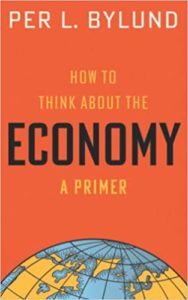
Per Bylund’s latest book titled How to Think about the Economy is a short introduction to the Austrian School of Economics at just under 150 pages. It contains chapters on entrepreneurship, economic calculation, the business cycle, regulation and most of what usually occupies scholars of this tradition. It aspires to achieve economic literacy in a quick and reader-friendly way. Many people will know him for his books The Problem of Production: a new theory of the firm and The Seen, the Unseen, and the Unrealized: How Regulations Affect Our Everyday Lives. He is also a fellow of the Mises Institute.
Professor Bylund’s appealing writing is suitable for a newcomer to economics. He manages to make concepts simple enough so the inexperienced reader can understand them, but not so simple as to become meaningless. The knowledge gained from the book will be enough for readers to then move to other Austrian school books. At the end of the book, Bylund has supplied us with a useful list of related readings. I suggest giving it a look for those interested in further learning. My personal suggestion would be going to Economics in One Lesson after finishing this.
It is inevitable that people will compare this book with other primers on Austrian economics and free market economics more broadly. Indeed, there are so many pop econ books out there- why is this one special? Why not Robert Murphy’s Choice: Cooperation, Enterprise, and Human Action or Introduction to Austrian Economics? These are just a small part of a huge list of books that fit this category. I liked this book because it was entertaining to read, and Bylund is straightforward and easy to follow. He doesn’t bombard you with information. It can be easy for someone new to economics, or any other field of study, to get lost if too much is presented at once. This book is a good stepping stone for attempting more complex works later on.
One thing that every reader should keep in mind is that he or she is reading an introduction to Austrian economics, which in many ways differs significantly from the orthodox approach. Per Bylund’s analysis of praxeology, business cycle theory, monetary intervention, and the minimum wage- among others- will go against what is commonly taught in most introductory economics curricula. Does this mean that the Austrians, and Bylund specifically, are wrong? This is a question too difficult to fit in a book review, but my short answer would be that it is a very good approach which, if not adopted, should at least be studied meticulously. The Austrians from Carl Menger to Murray Rothbard have taken part in the majority of important economic debates, and their writings on all important issues from marginal utility to economic calculation are always interesting to dive into.
One minor issue I would like to point out is that since this book is an introduction to the Austrian school specifically, it does not cover some commonly discussed issues like international trade or income inequality. The reader will not find much trouble learning about these topics from other more mainstream books or online resources, but this needs to be pointed out .
Who should read this book? If you want an introduction to Austrian economics, then by all means go ahead and read it. If you want an introduction to mainstream economics, try something else and you may read the book at a later date when you have a more solid grounding in the orthodox approach.
Chris Loukas was born in Greece and is an economic journalist and recipient of a bronze medal in the 2022 International Economics Olympiad. His articles have been featured by the Foundation for Economic Education, the Mises Institute and Adam Smith Works.


READER COMMENTS
Jonathan T Gress-Wright
Aug 23 2022 at 9:46am
It’s true that income inequality doesn’t play any central role in economic theory, at least not according to the Austrian school; in the unhampered market any existing inequality would simply be attributed to the unequal productivity of market participants. But we do not live in an unhampered market, so much of the current inequality may well be due to government intervention. I’ve seen Austrians touch on this here and there but I’d really like to see a more detailed study of existing inequality from an Austrian perspective. How much is likely due to unequal productivity and how much to intervention?
Mark Brady
Aug 23 2022 at 8:39pm
“It’s true that income inequality doesn’t play any central role in economic theory, at least not according to the Austrian school; in the unhampered market any existing inequality would simply be attributed to the unequal productivity of market participants.”
Maybe that’s what some self-identified Austrians would say. But I suggest that other members of the Austrian school would assert, and have asserted, that income inequality arises because of how private property rights are defined. Consider the site value of land, the term and duration of intellectual property, and the spectrum of free vs. unfree labor, and the incomes of those who receive or received ground rents, patent and copyright royalties, and income from the ownership of chattel slaves and claims on indentured (bonded) labor.
Comments are closed.